Eco Mowing: A Sustainable Approach to Lawn Care
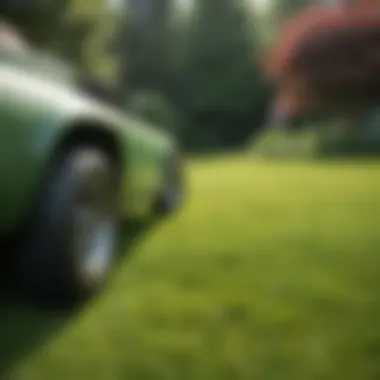

Intro
In the face of rapid urbanization and environmental degradation, the way we manage our green spaces has become a pivotal topic of discussion. Eco mowing, in particular, has emerged as a formidable approach to lawn care that prioritizes sustainability while ensuring our gardens flourish. By adopting methods that respect natural ecosystems, we can create vibrant yards without compromising the health of the planet.
The heartbeat of this practice lies in its philosophy: mowing shouldn't be just about aesthetics; it should also reflect a commitment to ecological balance. As more individuals embrace eco-friendly lifestyles, the gardening community is taking notice. It's not merely trimming grass; it’s a concerted effort to nurture the land.
Overview of the Topic
Intro to the Natural Resource
Lawn care often involves hefty input from fertilizers, pesticides, and gas-powered mowers that spit out emissions. Yet, our lawns are not just patches of grass; they represent a significant natural resource that can capture carbon, support biodiversity, and aid in stormwater management. Eco mowing seeks to harmonize the relationship between lawn maintenance and environmental stewardship.
Background Information on Significance of the Topic
The significance of eco mowing can't be overstated. This methodology reduces harmful outputs, conserves water, and promotes soil health. For an environmentally-conscious homeowner, it's a way to turn every square foot of grass into a little oasis that simultaneously beautifies the landscape and contributes to ecological sustainability. As climate concerns multiply, the need for eco-conscious practices like this becomes all the more pressing.
Current Status and Challenges
Current State of Environmental Concerns
At present, the lawn care industry remains heavily reliant on conventional methods. Gas lawn mowers dominate the market, contributing approximately 5% of air pollution in some regions. Add to this the excessive use of chemical treatments, and we have an alarming situation on our hands.
Identification of Challenges and Threats
There are several obstacles in transitioning from traditional lawn care to more sustainable metrics. These include:
- Cultural resistance: Many people are accustomed to standard practices and may be skeptical of alternative methods.
- Cost of equipment: Though eco-friendly tools are available, they often come with a higher upfront cost.
- Inconsistent information: Misinformation can muddy the waters, making it hard for consumers to make educated choices about their lawn care.
Sustainable Solutions
Exploration of Sustainable Practices
Sustainable lawn care practices offer a pathway forward. Among the most effective strategies are:
- Manual mowing: Pushing a reel mower can reduce emissions and even offer some exercise.
- Mulching: Leaving grass clippings on the lawn not only reduces waste but also adds essential nutrients back into the soil.
- Native plants: Incorporating native plant species into lawn designs can reduce the need for chemical treatments.
Case Studies of Success
Several communities have adopted eco mowing practices, showcasing significant improvements. For instance, the city of Portland implemented a program encouraging residents to transition to electric mowers, resulting in lower emissions and a greener environment. Not only did their air quality improve, but community buy-in was remarkably high, serving as a model for other urban areas.
Impact and Importance
Analysis of Impact
The impact of adopting eco mowing practices extends far beyond personal gardens. Collectively, if more individuals embrace these practices, we can see improvements in local ecosystems, including better air quality and reduced soil degradation. This is essential for communities—a healthy environment fosters strong, resilient neighborhoods.
Importance of Conservation Efforts
The importance of conservation in this context is paramount. Each small action contributes to a larger movement towards ecological sustainability. Moreover, fostering an environment where conservation is valued encourages future generations to appreciate and protect the resources we often take for granted. It’s not just lawn care; it’s a commitment to creating a thriving planet.
"In every blade of grass, a world of change is waiting to bloom."
By adopting eco-friendly mowing techniques, individuals can manifest a genuine connection to the earth, creating not only beautiful lawns but also a sustainable future.
Intro to Eco Mowing
Eco mowing represents a shift in how we perceive and manage our lawn spaces. The traditional approach often leans heavily into convenience, relying on gas-guzzling mowers and synthetic fertilizers, often leading to pollution and biodiversity loss. With eco mowing, there's a focus on sustainable practices that benefit both the environment and the beauty of our yards. This concept brings forth several vital aspects worth noting.
First, eco mowing prioritizes environmentally friendly tools and techniques. For instance, ultralight manual reel mowers, which operate purely on human power, facilitate a quieter and cleaner mowing experience. Additionally, the practice encourages natural lawn care methods that nourish the soil rather than deplete it. Individuals shifting toward eco mowing contribute positively against climate change and further support local ecosystems, making it a compelling case for anyone looking to nurture their green spaces sustainably.
Moreover, eco mowing is fundamentally tied to broader ecological principles, such as potential carbon footprint reduction and increased biodiversity. An eco-friendly lawn fosters habitats for various species, which can be as simple as allowing butterflies and bees to thrive through native plant inclusion.
Lastly, embracing eco mowing sends a ripple effect throughout communities, encouraging neighbors and local associations to rethink their own practices, enhancing collective environmental stewardship.
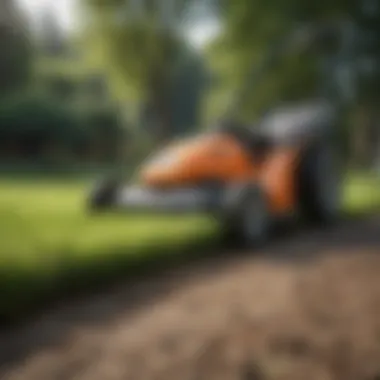
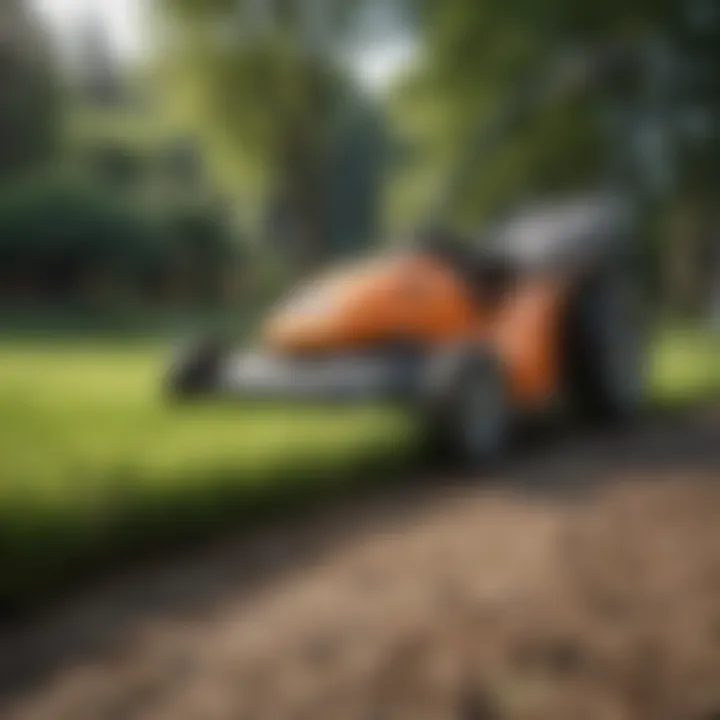
"A small action, like adjusting your lawn care approach, has the potential to create ripples of change in the community."
By invigorating discussions around eco mowing and its benefits, we pave the way toward more responsible choices in lawn care, steering clear of the mainstream, often detrimental practices. This initial exploration lays the groundwork for further sections discussing what eco mowing entails, its historical roots, and how it has evolved into a recognized approach today.
The Principles of Eco-Friendly Lawn Care
Understanding the foundational principles of eco-friendly lawn care is essential for anyone aiming for a robust and sustainable green space. These principles not only reduce environmental impact but also support the longevity and vitality of the lawn itself. The relationship between healthy soil, effective management practices, and biodiversity is pivotal. By embracing these principles, homeowners and gardeners can cultivate a lush lawn while treading lightly on our planet.
Sustainable Practices Overview
One can't speak of sustainability without emphasizing its role in lawn care. Sustainable practices revolve around methods and strategies that minimize harm to the environment. At the heart of these practices is the idea of using resources judiciously and efficiently. Here are some essential elements:
- Water Conservation: Implementing rainwater collection systems or using drip irrigation helps in saving water resources.
- Organic Fertilization: Utilizing compost or natural fertilizers like fish emulsion instead of chemical ones enriches the soil without introducing harmful toxins.
- Mulching: Returning organic matter such as grass clippings back to the ground improves soil structure and moisture retention. It’s like giving your lawn a nutrient-rich blanket.
Adopting these sustainable practices not only provides immediate benefits but contributes to the health of the wider ecosystem.
Soil Health and Management
Soil is the unsung hero of lawn care. It supports life above and below ground and plays a crucial role in the health of plants. When focusing on soil health, several considerations come into play:
- Soil Testing: Conducting regular soil tests to measure pH, nutrient levels, and organic matter content is fundamental. This information guides management practices and modifications needed for optimal grass health.
- Aeration: A technique that alleviates compaction, allowing for better air and water penetration. It helps roots breathe, making them stronger and more resilient.
- Organic Amendments: Adding compost or other organic materials enriches the soil. This practice enhances microbial activity, which is essential for nutrient cycling.
- Avoiding Chemical Inputs: Reducing reliance on synthetic fertilizers and pesticides contributes positively to soil health, ensuring it remains rich and alive with beneficial organisms.
Fostering soil health ultimately leads to a more vigorous lawn, ready to withstand pests and environmental stressors.
Natural Pest Control Solutions
Pests can be a real thorn in the side for anyone managing a lawn, but eco-friendly solutions exist that align with the principles of sustainability. Here are a few:
- Companion Planting: Planting specific plants together can deter pests while fostering beneficial relationships. For instance, marigolds can repel nematodes and other garden pests.
- Biological Controls: Introducing natural predators, like ladybugs for aphids, can help keep pest populations in check without the need for harsh chemicals.
- Neem Oil and Insecticidal Soap: These options serve as safe alternatives to traditional pesticides. They fight a variety of pests while being less harmful to beneficial insects.
"Embracing natural pest control not only protects your lawn but fosters a healthier ecosystem overall."
Ultimately, eco-friendly lawn care promotes a balanced approach, ensuring that the garden thrives while safeguarding the environment. By focusing on sustainable practices, managing soil health wisely, and employing natural pest control methods, homeowners can nurture their lawns in a way that's beneficial for both the land and for future generations.
Tools and Techniques for Eco Mowing
In the realm of eco mowing, the right tools and techniques serve as the backbone of effective and sustainable lawn care. Understanding the various options available empowers homeowners and lawn enthusiasts to make informed choices. Choosing eco-friendly mowers and adopting sustainable mowing techniques not only supports environmental conservation but also fosters healthier lawns. This section will delve into different types of eco-friendly mowers and the crucial techniques that can be employed to maintain a lush lawn while minimizing ecological impacts.
Types of Eco-Friendly Mowers
Manual Reel Mowers
Manual reel mowers are a time-honored choice when it comes to eco mowing. These mowers are simple, yet effective, operating without any fuel or electricity. The key characteristic of manual reel mowers is their reliance on human power, which contributes to zero emissions. One might think that they lack the effectiveness of modern machines, but quite the opposite is true. By moving at a slower pace, these mowers allow for precision cutting, which can ultimately lead to a healthier lawn.
Unique features of manual reel mowers include their lightweight design and ease of maintenance, making them an economical option. While some might find their physical effort rigorous, many appreciate the workout and connection to nature that using these mowers provides.
Electric and Battery-Powered Mowers
Electric and battery-powered mowers bring a contemporary twist to eco mowing. Their main advantage lies in their ability to combine efficiency with reduced environmental impact. Noise levels are significantly lower than gas mowers, making them a peaceful option for suburban neighborhoods. Another key characteristic of these mowers is their convenience; they start at the push of a button and require less maintenance compared to gas-powered alternatives.
A unique feature of electric mowers is their zero-emissions operation while in use. However, one downside could be the limited run time on battery-operated models, necessitating a bit of planning for larger lawns. Nonetheless, for those looking to reduce their carbon footprint, electric mowers are an increasingly popular choice.
Robotic Lawn Mowers
Robotic lawn mowers are the epitome of technological advancement in lawn care, bringing automation into the fold. Their key characteristic is their ability to operate independently, allowing users to kick back while their lawns are mowed with precision. These mowers utilize sophisticated sensors to navigate, avoiding obstacles and ensuring every inch of the lawn is cut evenly.
What stands out with robotic mowers is their unique feature of scheduling and remote operation via smartphone apps. However, there are caveats; they can be a bit pricier than traditional mowing options and may require specific settings to avoid getting stuck in challenging terrains. In sum, for tech-savvy homeowners, these mowers represent innovation paired with sustainability.
Mowing Techniques for Sustainable Lawns
Regular Height Maintenance
One critical aspect of maintaining a sustainable lawn is regular height maintenance. This involves mowing at the appropriate height for different grass types and conditions. The key characteristic here is that keeping grass slightly longer encourages healthier roots and reduces the need for watering. Taller grass also shades the soil, which helps to keep it moist while hindering weed growth.
A distinct benefit of this technique is that it supports a robust ecosystem. Healthy lawns aid in carbon capture, making every trim count toward environmental betterment. While some might prefer the uniformity of a cropped lawn, the natural look of longer blades can enhance biodiversity.
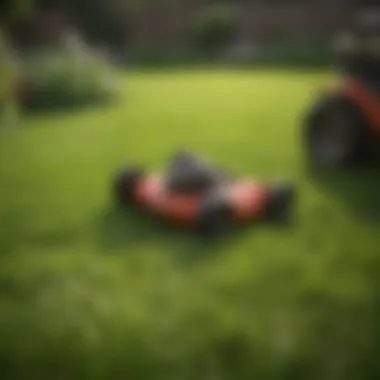
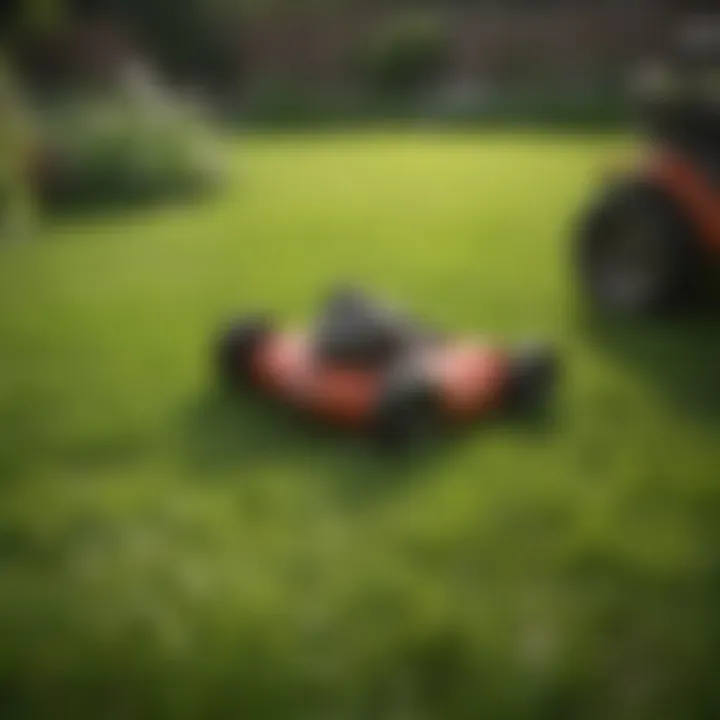
Grasscycling Practices
Grasscycling is a fantastic method for sustainable lawn maintenance that involves leaving grass clippings on the lawn after mowing. The key benefit of this practice lies in its ability to recycle nutrients naturally back into the soil. Think of it as converting waste into value! It provides essential nitrogen, phosphorus, and potassium without the need for chemical fertilizers.
One unique feature of grasscycling is its simplicity—there's no extra work needed except to modify your mindset about leftover clippings. However, care must be taken to avoid excessive clumping, which can smother the grass beneath. When done right, grasscycling becomes a nifty way to maintain nutrient-rich soil.
Seasonal Strategies
Adopting seasonal strategies for mowing means adjusting yard care practices according to the changing seasons. This technique is particularly beneficial as it aligns mowing frequency, height, and other tasks with the natural growth cycles of various grass types. The key characteristic of this approach is its adaptability, making it specific for local climate conditions and grass type.
For example, during fall, one might allow for slightly longer grass to promote winter hardiness. As spring arrives, adjusting the mowing height to prevent scalping becomes essential. The unique feature of using seasonal strategies is that it sets a rhythm with nature rather than against it. Such an approach can significantly reduce stress on both the lawn and the mower.
Ultimately, the tools and techniques of eco mowing come together to create a symphony of sustainability. By embracing these options, individuals can cultivate green spaces that benefit both people and the planet.
Ecological Impact of Eco Mowing
The ecological impact of eco mowing cannot be understated. This practice serves a dual purpose: maintaining lush green landscapes while promoting environmental wellness. When employed correctly, eco mowing techniques do not just take care of our lawns; they can actually help heal our ecosystems. Understanding this impact is pivotal for anyone wishing to embark on a sustainable lawn care journey.
Carbon Footprint Reduction
One of the most significant benefits of eco mowing is the reduction in carbon footprint. Traditional gas-powered lawn mowers emit greenhouse gases that worsen climate change. In contrast, eco-friendly mowers, whether they are manual, electric, or battery-powered, substantially mitigate this pollution.
Consider this: a gas mower can emit as much pollution in one hour as driving a car for over a hundred miles. This shocking statistic emphasizes the importance of reducing reliance on these machines. By making the switch, not only do we contribute to a cleaner atmosphere, we also lower noise pollution, making our neighborhoods more serene.
"Cutting down the fuel dependency in lawn care is like taking a few cars off the road in your community."
Engaging in practices like grasscycling—where clippings are left on the lawn to decompose—further assists in carbon uptake by plants, enriching soil and promoting healthier grass growth. Hence, carinbg for your lawn with environmental sensibility not only leads to better grass but also plays a role in climate regulation.
Biodiversity Enhancement
Another vital aspect of eco mowing is its capacity to bolster biodiversity. A healthy ecosystem thrives on variety, and our lawns can contribute immensely by becoming wildlife-friendly habitats. Choosing native plants instead of exotic species can foster an environment where local fauna can flourish, creating a welcoming habitat for beneficial insects, birds, and even small mammals.
Incorporating diverse plant species helps maintain balance in the ecosystem. For instance, certain lawn grasses provide food for specific birds or insects. Additionally, a varied landscape can decrease pest infestations, as a diverse group of plants can often outwit pests that target one specific variety.
On a broader scale, practices linked to eco mowing can support pollinators, like bees, which are essential for other crops and flowers. Implementing simple changes in mowing patterns—such as leaving certain areas unmown or reducing the mowing frequency during blooming seasons—makes a notable difference in supporting these fragile populations.
In summary, the ecological impacts of eco mowing create a ripple effect far beyond the well-trimmed lawns. By prioritizing practices that reduce carbon footprints and enhance biodiversity, we can foster healthier communities and contribute positively to our planet.
Comparative Analysis: Traditional vs. Eco Mowing
Analyzing the differences between traditional lawn care practices and eco mowing is crucial for understanding how our gardening choices impact the environment. With increasing awareness about sustainability, more people are weighing the benefits of eco-friendly options against conventional methods. This section aims to shed some light on this comparison by focusing on two specific aspects: resource consumption and long-term cost efficiency.
Resource Consumption
Resource consumption in landscaping is often scrutinized, especially today when our planet's health is a top priority. Traditional lawn care methods frequently rely on fossil fuel-powered mowers, fertilizers laden with chemicals, and excessive water usage.
- Fuel-Dependent Equipment: Gas-powered mowers are notorious for high fuel consumption, contributing significantly to air pollution and greenhouse gas emissions. In some areas, a single hour of mowing can release as much pollution as driving a car for several hours.
- Chemical Fertilizers: These products not only multiply resource consumption but also run the risk of nutrient runoff, which ends up in waterways, potentially harming marine ecosystems.
In contrast, eco mowing employs strategies designed to minimize resource use while achieving healthy grass growth without undue harm to nature.
- Manual and Electric Mowers: They will generally use fewer resources. For example, a manual reel mower needs no fuel and can actually offer a solid workout at the same time, knocking out two birds with one stone.
- Sustainable Practices: Techniques such as grasscycling allow for clippings to nourish the soil, returning valuable nutrients without the need for synthetic fertilizers. This not only cuts down on resource use but also encourages a self-sustaining lawn ecosystem.
Long-Term Cost Efficiency
At first glance, eco mowing may seem like an investment of time and money, particularly if you're transitioning from traditional methods. However, examining it through the lens of long-term cost efficiency reveals a more favorable picture.
- Lower Fuel Costs: Since eco-friendly mowers are often electric or manual, homeowners see a notable decrease in fuel expenses. According to some studies, switching to electric or battery-powered mowers can save homeowners hundreds in fuel costs over several years.
- Reduced Chemical Purchases: By practicing eco mowing, you also find that there’s less need to constantly replenish fertilizers, herbicides, and pesticides. Many who adopt these practices enjoy a natural lawn’s resilience, reducing the dependency on synthetic chemicals. The result? A lighter financial burden on the homeowner.
- Increased Property Value: Sustainable practices may also contribute positively to property values in eco-conscious neighborhoods. Homebuyers increasingly seek properties that embody sustainable practices, potentially leading to higher resale values.
"Investing in eco-friendly lawn care is not just about maintaining beauty but ensuring that our gardens also play their role in the larger ecological narrative."
The trajectory toward a greener world is laden with numerous factors that affect cost efficiency in the long run. By abandoning unsustainable methods, one moves towards enriched lawns and a more sustainable lifestyle.
Through this analysis, it becomes clear that while eco mowing may involve initial shifts in mindset and method, its benefits thoroughly outweigh the traditional approaches. Resourcing sustainability serves not only the environment but can also become a wise financial choice.
Challenges in Adopting Eco Mowing


While the concept of eco mowing offers numerous benefits for the environment and long-term lawn maintenance, it doesn't come without its hurdles. Addressing these challenges is key to facilitating the widespread adoption of sustainable practices in lawn care. A successful transition to eco mowing needs to tackle specific concerns, from the financial aspects to societal perceptions. These points of contention play a significant role in shaping individuals' willingness to make the switch.
Initial Investment Costs
One of the primary barriers to embracing eco mowing is the initial investment required for eco-friendly tools and techniques. The upfront costs associated with purchasing electric mowers or maintaining native plant gardens may deter homeowners and small businesses alike. For instance, a quality electric mower can set you back several hundred dollars more than traditional gas-powered versions.
Yet, it’s crucial to see this as a long-term investment rather than an expense. Many electric mowers have lower operational costs and require less maintenance, potentially saving homeowners money over time. To illustrate, an electric mower might cost $500 initially but can save around $25 per year in fuel costs alone. Over a few years, such savings can accumulate, offsetting the higher price point. Furthermore, maintaining biodiversity and soil health through eco mowing can lead to a more resilient lawn, reducing the need for costly interventions like fertilizers and pesticides.
Community Perception and Acceptance
The acceptance of eco mowing within local communities presents another significant challenge. Lawn care is often deeply ingrained in cultural practices, and many individuals may resist change due to established norms. Some folks view traditional mowing as a universally accepted standard, viewing anything else as fringe or unnecessary. This perception can create social pressure, leading to reluctance among those considering eco-friendly alternatives.
"A cow likes a variety of grasses. A mower? Not so much. But a community well-nourished in sustainability can change that."
To foster acceptance, education about the benefits of eco mowing is essential. Highlighting its role in promoting biodiversity, reducing carbon footprints, and improving soil health can help sway opinions. Organizing local workshops or community events where residents can trial eco mowers may also provide firsthand experience, poising them to embrace these practices. When neighbors see each other adopting eco-friendly techniques and achieving lush, healthy lawns, it can cultivate a culture where sustainability thrives.
Best Practices for Eco Mowing
When it comes to eco mowing, laying out best practices is essential for fostering a sustainable lawn care routine. These practices serve not just the aesthetic appeal of the lawn, but more importantly, they contribute to the larger goal of ecological preservation. Just like a well-tended garden, a sustainable approach requires careful planning, frequent attention, and an understanding of the environment.
Creating a Lawn Care Schedule
A structured lawn care schedule is the backbone of any effective eco mowing strategy. Proper timing can directly influence growth and overall health. Setting a mowing schedule that aligns with the grass growth patterns ensures that you are not cutting too frequently or too infrequently. This balance allows the grass to maintain its vigor while minimizing stress.
"Consider the seasonal changes that affect growth. For instance, during spring and early summer, grass typically grows faster, while in late autumn, it slows down. Adjust your mowing frequency accordingly."
Additionally, mowing during the cooler times of the day, such as early morning or late afternoon, can prevent heat stress on the grass. An air of systematic approach helps maintain healthier lawns, while reducing the necessity for excessive watering or chemical interventions.
Integrating Native Plants
Integrating native plants into your lawn not only enhances biodiversity but also supports local wildlife. Native plants are well-adapted to the local climate, soil, and pests. This means they typically require less water and fewer chemicals than non-native species. They form a resilient ecosystem that will creep less into general gardening maintenance as they thrive without too much help from humans.
Consider spreading clover along with your grass patches; it naturally fixes nitrogen in the soil, improving fertility without needing artificial fertilizers.
Benefits of utilizing native plants include:
- Improved Soil Health: Native plant roots help rejuvenate topsoil.
- Pest Control: Native flora attract beneficial insects and pollinators.
- Drought Resistance: These plants can withstand periods of low moisture.
Participating in Local Conservation Efforts
Active engagement in local conservation initiatives is another beneficial practice for eco mowing. Many organizations promote community-based projects, such as tree planting, invasive species removal, and habitat restoration. By getting involved, individuals not only contribute to a greater cause but also connect with like-minded enthusiasts.
Consider participating in events hosted by local conservation groups or volunteering for clean-up efforts in nearby parks. This participation can often be transformed into educational opportunities. It’s a chance to share insights on sustainable practices with your community or learn new techniques.
By adopting these best practices for eco mowing, individuals can make significant strides toward achieving a vibrant and sustainable lawn, while fostering a stronger sense of community and connection to nature.
Ending: Embracing Eco Mowing
As we wrap up our discussion on eco mowing, it’s essential to grasp its significance in modern lawn care. This approach is not just about making lawns look good; it's a cornerstone for sustainable practices that respect our environment. Embracing eco mowing enhances the health of our ecosystems while also giving us a chance to enjoy our outdoor spaces responsibly.
One of the paramount benefits of eco mowing lies in its ability to significantly reduce the carbon footprint associated with lawn maintenance. By opting for manual or electric mowers, homeowners help decrease greenhouse gas emissions, contributing to a cleaner, healthier atmosphere. It’s about making choices that resonate with the principles of sustainability.
Furthermore, adopting eco-friendly practices promotes biodiversity. Native plants, which can easily be integrated into your lawn, provide habitats for local wildlife and insect species. This practice in itself can lead to more vibrant ecosystems right in our backyards. It's a small shift that can produce profound changes—nature is resilient and can thrive with just a little help from us.
"Sustainability in lawn care isn’t merely a trend; it’s a necessary evolution that benefits both the environment and our communities."
The Future of Lawn Care
Looking ahead, the future of lawn care seems intertwined with sustainable practices like eco mowing. Changes in climatic conditions and increasing awareness about environmental issues have spurred a shift in how people view lawn maintenance. The days of solely relying on heavy machinery and chemical-laden fertilizers are fading.
Innovative technologies are emerging. For instance, advancements in battery-powered and solar-powered mowing equipment could soon become standard. This evolution is promising, helping reduce noise pollution and emissions while simplifying the mowing process. Just think about the quiet whir of a battery mower as opposed to the roar of a gas engine!
Moreover, educational programs aimed at teaching sustainable gardening practices are on the rise. As more individuals become aware of the ecological implications of their lawn care choices, we can expect an increase in implementation of native plant species and organic maintenance techniques. The movement towards eco mowing is likely to gain momentum, resting firmly on the foundation of community engagement and environmental stewardship.
Final Thoughts on Sustainable Lawn Maintenance
In closing, sustainable lawn maintenance is more than a passing phase—it's an integral part of a larger, global conversation about how we coexist with our environment. Much like caring for a garden, nurturing a lawn with eco-friendly practices requires patience and commitment but yields enriching rewards.
Those who choose to adopt eco mowing help set a precedent for future generations, ensuring that vibrant, healthy lawns can exist alongside flourishing ecosystems.
Every blade of grass cut, every flower nurtured speaks volumes about our priorities, reflecting a shared responsibility towards nature. By making conscious choices now, we lay the groundwork for a greener tomorrow—one where our outdoor spaces continue to serve as sanctuaries for humans and wildlife alike.
As the seasons change and lawns grow, so can our approaches to their care. Remember, every little effort counts, and the impact of embracing eco mowing is felt not just today, but in many tomorrows to come.



